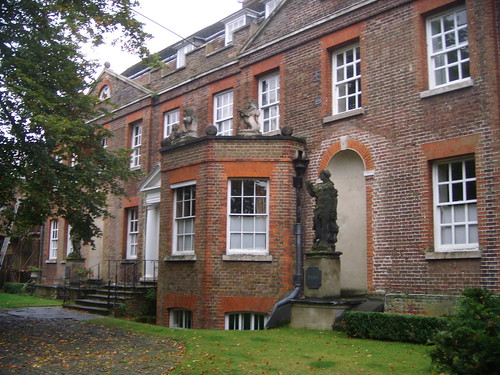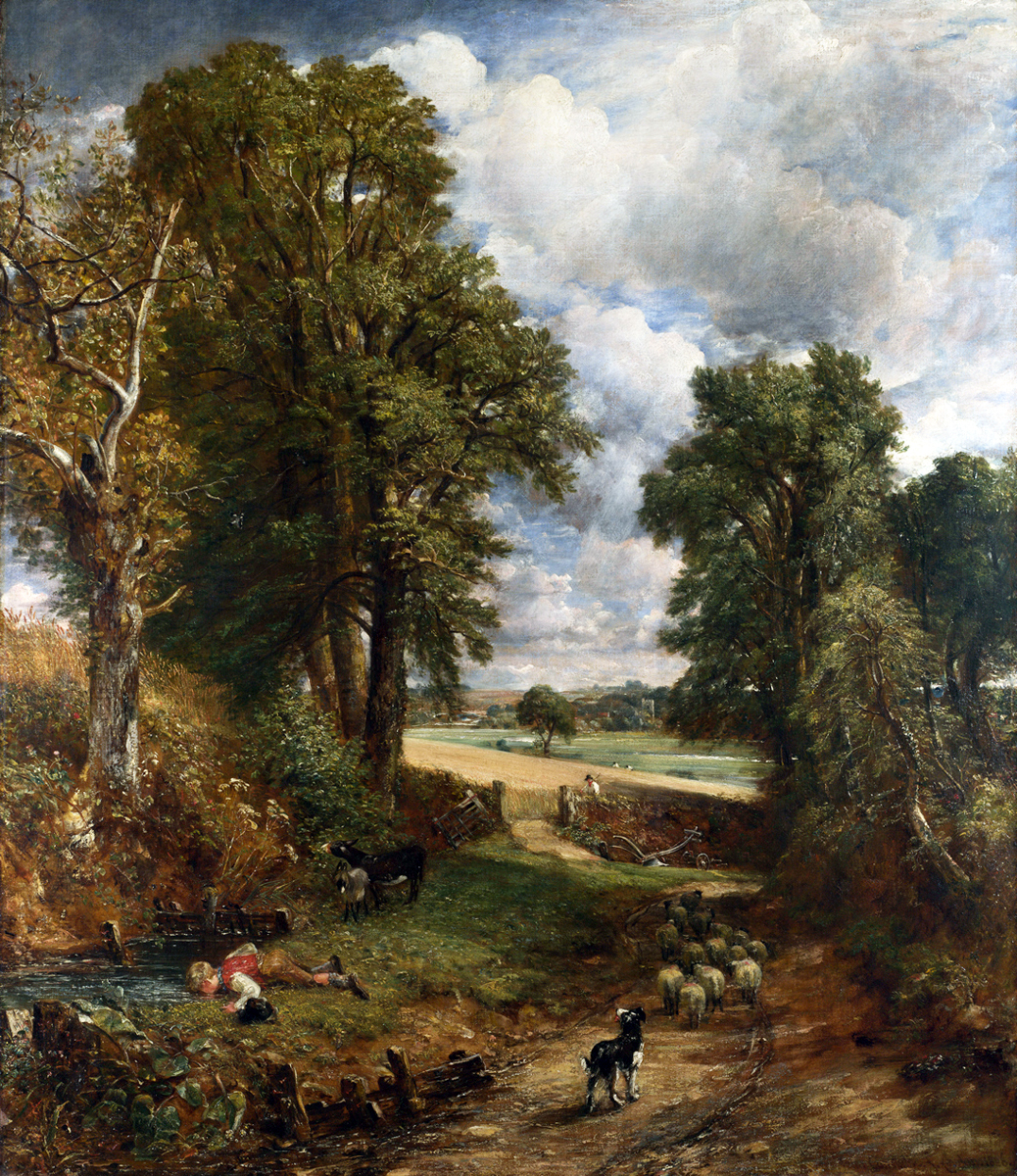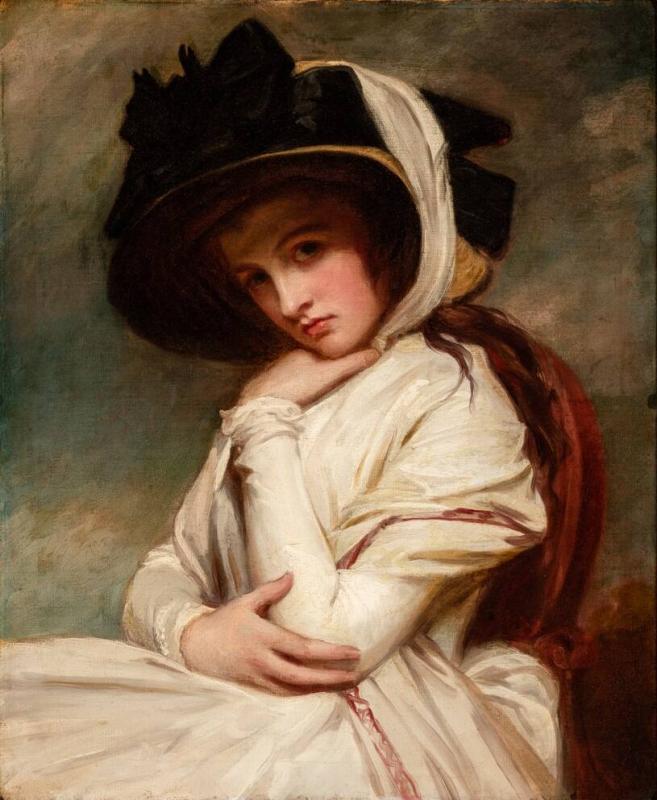I wonder if the lovely weather of this weekend is the swan-song of this year's English summer. Last year was a nonstop drizzle, gloomy and boring and enervating. In contrast, there have been several spectacular days this year. And in anticipation of it all going grey in the foreseeable future, I betook myself to Southside House by Wimbledon Common, next door to King's College School, that powerhouse of academia for boys.
Considering I've been in London for over five years now, and have been to pretty much every stately home with art in town, not having heard of Southside till about a month ago is a considerable lacuna in my experience. Pierre had been a few weeks ago and he adjured me to visit. "It is marvellous," he said, "The chandeliers, the Van Dycks, the Constables..." A Constable, eh? I thought to myself. Now that I gotta see.
The rather sparse website for the house reveals that it is privately owned, and is only open from Easter to the end of September every year. Today, in other words, is the last day this year it will be open. Three guided tours are organised at £5 a head. The tour lasts about an hour. Did I want to wait till 2009 to explore it? Nah.
 A huff and a puff and a long haul up the hill to the Common and past its southern edge brought me to Southside, hidden behind verdant trees. It is built in the William and Mary style, a sort of Dutch-English architecture, although it has several Georgian features as well. Two hand marks embedded on the top facade, by the engraving of a year 1757, are a sign that the place is insured - without the mark, the fire brigade of the time wouldn't help out in case of a conflagration! Urns appear on the balustrades, marking the house as one of great wealth.[Picture by Ridgway.]
A huff and a puff and a long haul up the hill to the Common and past its southern edge brought me to Southside, hidden behind verdant trees. It is built in the William and Mary style, a sort of Dutch-English architecture, although it has several Georgian features as well. Two hand marks embedded on the top facade, by the engraving of a year 1757, are a sign that the place is insured - without the mark, the fire brigade of the time wouldn't help out in case of a conflagration! Urns appear on the balustrades, marking the house as one of great wealth.[Picture by Ridgway.]
By the entrance, a sign said 'Private' and another requested visitors to head around the side of the house to the Garden Room at the back. A genial gent met me there and nicked a fiver off me. I looked around - there were eight or so people around, all of whom admitted to being long-term residents of Wimbledon. Most of them were at least a century old. It has by now ceased to amaze me that I invariably find myself the youngest (and the brownest) at such places.
A genial lady - one of the local experts working at the restoration and preservation of the property - was our guide. In the Garden Room were two old trunks, one of Victorian black leather and the other a Louis Vuitton dress box. These were, she said, found in the basement of the house. They had been locked and put away for decades. When they were opened up, a treasure trove of middle Victorian costumery was found in it (some of which is on display inside the house). Children's costumes, women's hats, elegant dresses - a haul that had the curators of the Victoria and Albert Museum salivating (the V & A has possibly the finest collection of historical haute couture in the world).
I won't go into the history of the house itself or of the family - Anglo-Swedish in descent, polymathic in ability - you can read it all up at the website. Suffice it to say, despite onerous death duties and heavy costs of maintenance, the house has remained (in trust) under the control of the family for centuries, and they fully intend to keep it that way, and accessible to the public for as long as possible.
[By the way, it appears that there's still a couple of chances to enter at least part of the house this year. The Wimbledon Bookfest 2008 has organised talks in the premises. The Festival starts in a few days, so hurry!]
There are indeed Van Dycks - several studio paintings, more often than not executed by his assistants, but also a couple of signed ones, which imply that the master himself painted at least the face and the hands of the sitters. Van Dyck believed that the long tapering fingers and straight regal noses were the epitome of beauty and elegance, and he insisted on beautifying his subjects. They, of course, loved it, for he made them appear far lovelier than ever they were. His portraits in the house are not of immensely famous people; in fact, I hadn't heard of any of them.
At one time, it was quite the thing to have miniature portraits made of distinguished members of the family, and so one finds, for example, Mary Boleyn, sister of the unfortunate Anne, who is a distant relative. There are also lovely old clocks everywhere; in particular, one elegant bracket clock which played several tunes when it struck the hour, and also had little chains to the side that enabled one in the middle of the night, say, to ascertain what hour it was by pulling it, and not requiring recourse to candles and all that.
It is said that every stately home in England at one time or the other would have hosted royalty. Southside House is no different. Edward VII, when he was still heir to the throne, liked to meet his mistress Alice Keppel here (she could gain access to his bedroom via a secret passage and steps from the side of the house).  She wouldn't spent the whole night with him, oh no, so she had her own bedroom behind his.
She wouldn't spent the whole night with him, oh no, so she had her own bedroom behind his.
The main dining room is where one finds a glorious French chandelier. One can hire the room for soirees and the like, and the candles would be all lit up, illuminating the signed Van Dycks on the walls. Unlike Van Dyck, who airbrushed perfection into his sitters, Hogarth painted what he saw; needless to say, he wasn't a popular portraitist in Georgian England. Still, one can see a portrait by Hogarth in this room, and it is of one of Hogarth's friends, whose name escapes me at the moment. There is also an Edward Burne-Jones portrayal of an effeminate looking St George with a dragon coiled behind him.
For me, the high-point was a quickly executed sketch by John Constable which served as study for the lovely Cornfield painting that one can see at the National Gallery. At the time, there were no tubes to maintain oils moist and usable, so artists had to tote their paint in pigs' bladders, and paint rapidly before they dried. This explains, of course, why Constable always prepared several sketches and studies onsite before heading back to his own studios to fulfil the final artwork. In this case, the little boy trying to drink water from the Suffolk stream and his puppy are missing; the sky is somewhat overcast, and the trees are dark and brooding; quite unlike the optimism and light of the finished work.
 Various worthies frequented this old house. Emma Hamilton visited with Lord Nelson. There's a portrait of her in the Musik Room, by George Romney that shows off all her beauty - and what a beauty she was. In her time, she was known for her Attitudes. Mistresses such as her were expected to entertain their lovers' friends either by singing or engaging conversation. She bedecked herself in the loose bust-revealing clothes (which then became the fashion, as we see from the descriptions of the dresses worn by women in Jane Austen's novels) and assumed erotic poses, much to the delight and satisfaction of the men present. Romney was obsessed with her, and painted her several times - see here, for example. (The image on the left is from the Huntington Library in San Marino, California.)
Various worthies frequented this old house. Emma Hamilton visited with Lord Nelson. There's a portrait of her in the Musik Room, by George Romney that shows off all her beauty - and what a beauty she was. In her time, she was known for her Attitudes. Mistresses such as her were expected to entertain their lovers' friends either by singing or engaging conversation. She bedecked herself in the loose bust-revealing clothes (which then became the fashion, as we see from the descriptions of the dresses worn by women in Jane Austen's novels) and assumed erotic poses, much to the delight and satisfaction of the men present. Romney was obsessed with her, and painted her several times - see here, for example. (The image on the left is from the Huntington Library in San Marino, California.)
There's also a self-portrait of Joshua Reynolds that's interesting in its honest depiction of the old man he has become. A grand piano - still played on during concerts arranged at Southside - is present in the Musik Room, as are two enormous Japanese ceramic vases, picked up, we are told, during one of the European grand tours undertaken by the Pennington-Mellor-Munthes, whose descendants run the show now.
A tapestry room near the Musik chamber is somewhat noteworthy in having old tapestries hanging on the walls, with badly faded Italian art painted on. More interesting is the little cubby hole behind one of the tapestries which served as powder-room (and is now an unadvertised toilet, requiring careful handling when flushing!). Georgian gentlemen riding up to the house needed to powder their wigs before entering the lounge, so they would cover their faces with a mask and stick their heads backwards through an aperture into the cubby hole, where a little minion would dust their wigs for them with powder. The powder contained arsenic, which would explain the masks over the gentlemen's faces, but the poor sod who had to arrange their wigs clearly had no such protection.
No tale of stately homes is complete without spectral visits, and so it proves to be the case here. A little while ago, a lady attending a concert in the Musik room went into that wig-powdering cubby-hole - which, as I explained, has been converted into a toilet - and came rushing out a little while later, gasping and trembling. When asked what happened, she said she had felt someone adjusting her hair, brushing it and patting it down. There had been nobody but her in the room. She had never been to the house before and had no idea that the cubby-hole had been used to powder wigs. It became clear to everyone present that she had been assisted by one of those poor sods of the Georgian period who had no doubt died there after inhaling all that arsenic. Despite the passing of the years, the ghost of the fellow assiduously kept up his responsibilities.

0 comments:
Post a Comment